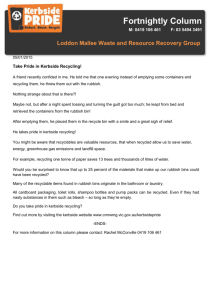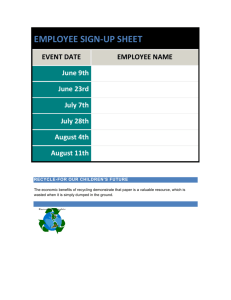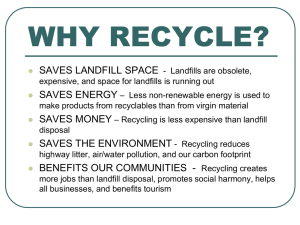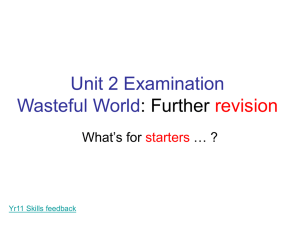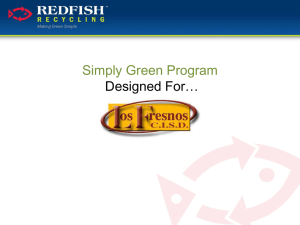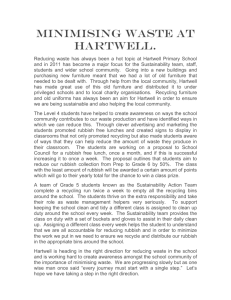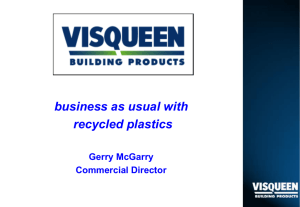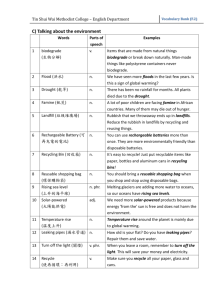A Wasteful World
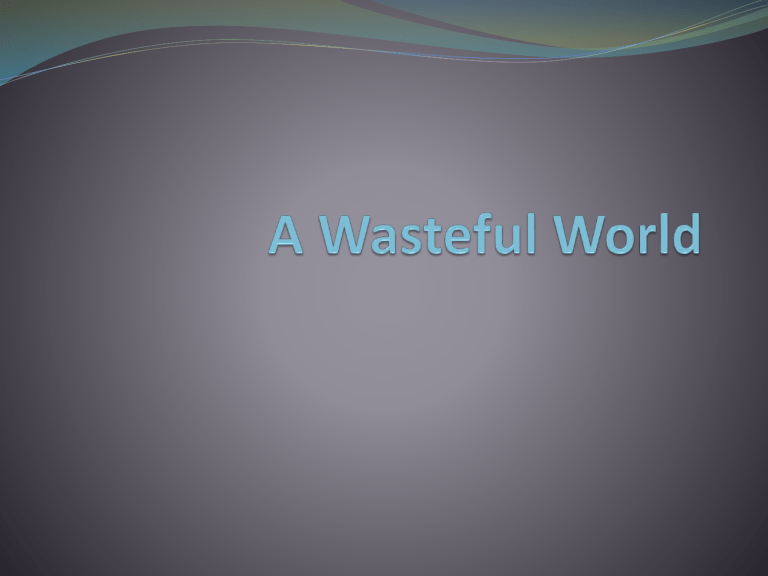
Types of Waste
Biodegradable/Non Biodegradable
Domestic/Industrial
Hazardous/Non-Hazardous
Solid/Liquid
Come up with an example of each if you can
HIC/MIC/LIC
HIC stands for Highly Industrialised Country e.g. USA
MIC stands for Mostly Industrialised Country e.g.
India
LIC stands for Less Industrialised Country e.g.
Bangladesh
Who produces more waste?
HIC countries usually produce more waste as they have higher levels of disposable income and the constant need to have the latest and greatest gadgets
20% of the worlds population who live in HIC’s produce 86% of the consumption of the worlds products
Poorest 20% consume only 1.3% of the worlds products
Copy figure 1 pg 124 into your books to explain this more
Look at the table on pg 124 (figure 2)
What is it showing us?
Look at the following countries information: USA,
Australia, Kuwait, United Kingdom, Germany. What do you notice?
Look at the following countries information:
Cameroon, Kenya, Ethiopia, Congo, Bangladesh. What do you notice?
What is the map showing us on pg 125?
How is it different to a normal map of the world?
The map is showing the amount of waste collected from homes, schools and businesses
How it is different to a normal map is that the more waste a country produces, the fatter that country seems on the map. Look at the size of the US for example
Look at the size of Africa on the map, what do you think this tells us about the amount of waste produced there?
What is the waste made up of?
Look at figure 4. It breaks down how domestic waste is created. Over a third of it is from packaging
This diagram has changed over time. 50 years ago the % of fires/ashes would have been much higher, why do you think this?
Nappies would not have been invented either, as babies would have had cloth nappies instead of disposable ones, so they would be reused
E-waste didn't exist really either, now it is a massive contributor to domestic waste due to the demand to have the latest and greatest gadgets even if we don't need them!
United Kingdom: What happens to the waste?
2003/04: 72% went into landfills (hole in ground), 9% incinerated (burned) 19% was recycled
By 2007 it was up to 31% recycled
This is good because it means less in landfills and being burnt, this means less greenhouse gases in the environment
How is waste recycled at local level
Most councils or local authorities in the UK and other countries have set up recycling centres.
These centres are specifically set up to deal with certain types of recycling e.g. cans, glass, paper
Usually the recycling is put into specific bins by the public and put out to be collected on certain days (see the pictures pg 126)
How is the recycled material used?
Look at the 4 orange boxes on page 127
Read through each box carefully. You then need to write what you consider to be the 4 most important pieces of information for each box in your book. We will then share these as a class and come up with what we consider to be the most important points
Don't just pick the first 4 points either as I could assess you on this in tests and/or the exam!
HIC’s...How do they get rid of the rubbish?
Many different types of waste e.g
municipal waste, nuclear waste, other types of toxic waste
Municipal Waste
Germany known as recycling capital of Europe, produces 14 million tonnes of municipal waste each year of which 60% is recycled
Quarter of a million people employed in waste management industry
1970’s 50,000 landfills in Germany, now only 160 and waste has to be treated
They also incinerate rubbish
People who run these plants are exempt from carbon emission rules which creates problems (see pg 128)
They also send rubbish to other countries and other countries also send their rubbish to be disposed of by
Germany, its a big business!
But there are problems with the recycling system, copy the 4 bullet points from pg 129 that explain these problems
Nuclear Waste
Doesnt have any sites to reprocess or treat this kind of waste, so it has to be sent overseas
Doing this is very expensive for Germany to places like
France, UK and Siberia
Hopefully they will eventually be able to deal with all their nuclear waste. They are hoping to be able to do this within the next few years
Other toxic waste products
Most of this type of waste is sent overseas
Alot of it was sent to Eastern Europe
One famous example of this going wrong involved shipping toxic waste to Albania
The waste was labelled as aid for use in farming
But it had dangerous pesticides in it like toxaphene
If you put a litre of toxaphene into water it can contaminate
2 million cubic litres of water
There was 6000 litres of it in the 480 tonnes. It would cost
$5500 a tonne to get rid of the pesitcides
This caused many problems
Questions
Answer the Foundation questions and then the Higher questions from pg 130. You need to show me these questions next week (Sunday for girls, Tuesday for boys) for your second homework
Test: How and what to study, up to you if you follow these tips!
Pgs 124-130
Types of Waste and its production/Recycling and disposal of waste
Look at the notes we have made in class
Look at the headings in the blue boxes on each page
Make sure you understand in particular the diagrams/tables and what they are showing
Look at the learning outcomes/objectives of the two sections
The review boxes on pg 125 and 130 explain what you should know
Orange boxes pg 127-know this!-you should already if you did you homework!
Sources and Uses of Energy
Look over the table on pgs 131-132. You dont need to know everything on it, just be able to refer back to maybe 1 or 2 examples of types of fuel if asked to do so in an assessment
Ground Source Heating
Can save you 70%
Does not give off greenhouse gases
Cheap in the long term as infinite resource (never run out), but its expensive to build in first place
Need space to build it
It works by taking heat from the ground into pipes filled with chemicals and water that are then heated
Power from the Sun
Two options- photovoltaic cells and solar panels
PC- expensive to install, but is fitted onto buildings.
Also not nice to look at
They are panels/tiles which produce energy from light
SP- can provide you with most of your hot water, no ongoing costs, fitted to building, but not good in places with not much sun
Fluid in the panels heat up producing hot water
Wind Power
Turbines are used to produce energy
They are quiet and efficient, dont give off any emissions
Needs to have a certain wind speed to work, not nice to look at and can affect local wildlife patterns
Power from water
Controlling water to power turbines, can be done with rivers or tidal water
Cheap to run as water is infinite resource
Expensive to build
Can affect the environment in different ways
Management of energy usage and waste
Energy usage has doubled every 20 years
But we waste most of the energy through a number of ways
Copy the red bullet points from pg 135
The wasted energy could supply 66,000 homes
Energy wastage continues to rise because we are building bigger homes and these need more energy
Heating and cooling systems and dishwashers use the most energy
How do we waste energy in school and at home?
Think about how we use energy here at school and at home. We are all guilty of wasting energy e.g lights being left on when no one in a room, tv left on standby, phone chargers plugged in with no phone charging
Your task is to make up a list of areas at home and at school where energy is being wasted. You then need to come up with a viable solution to the problem. Some will be more complicated than others. You need to do this as it will be part of your next assessment
